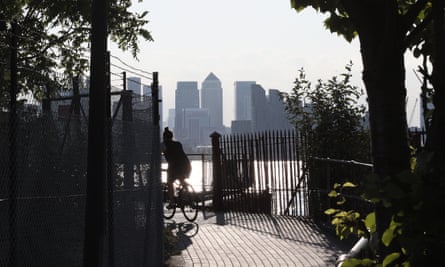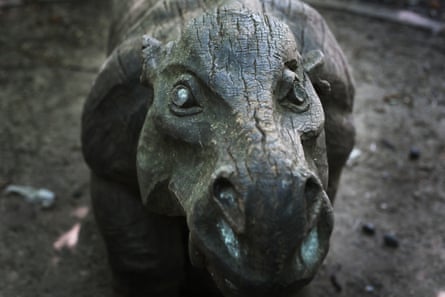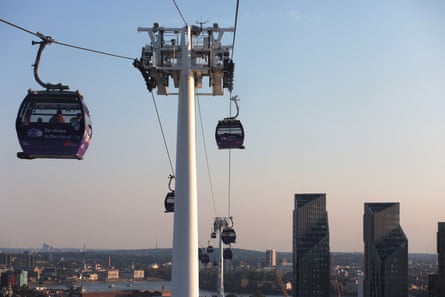Near the start of his book Otherlands, palaeobiologist Thomas Halliday sketches the London landscape 50 million years ago: swampy forest and tropical waters filled with crocodiles, sea turtles, mangroves and huge lily pads. Otherlands is a compelling recreation of vanished ecosystems and the ways in which they can help predict possible outcomes of the changing climate. I meet the author for a riverside walk to explore modern London and its traces of past landscapes, and to look at what the future might hold.
My temporal adventure starts, before we meet, in Lesnes Abbey Woods, easy to reach on the new Elizabeth Line. With its 12th-century abbey ruins, bronze age tumulus and ancient mossy forests, walking in this area has always felt like time-travelling. Squirrels and squawking green parakeets flash through the trees as I follow signs to a fossil bed, a sandy area where anyone can come and search for 50-million-year-old shells and sharks’ teeth. A wooden coryphodon, an extinct semi-aquatic mammal whose remains have been found here, guards the entrance.

Two cheerful pre-schoolers are scraping the dirt with yellow plastic spades. In another corner, an older kid digs patiently with a metal trowel and sieve and soon turns up a sand shark’s tooth, hardly bigger than a blackberry prickle. He offers it to me with the insouciance of a veteran palaeontologist: “I’ve got a whole jar of them at home.” How long has he been interested in fossils? “Since I was born, I think,” he grins up briefly from the serious work of sifting the primeval earth.
Round the corner, three replica arched windows frame a view of Canary Wharf, which is roughly where I’m headed. I follow the Green Chain walk a couple of miles to the river, where it joins the Thames Path. Hurrying now to reach our meeting point before low tide, I pass eclectic relics of the river’s varied history: piers, jetties, wrecked barges, canals that carried gunpowder, and concrete pillboxes from the second world war.

Near the iron Edwardian lighthouse at Tripcock Ness, I catch up with Thomas and we walk along a stretch of river known as Gallions Reach, searching for clues to an earlier topography. The roots, stumps and spongy trunks of a 5,000-year-old drowned forest fringe the muddy foreshore, exposed among the grey-black peat and alluvium as the tidal estuary empties twice a day. We step through slippery green rocks and tidal detritus to find these ghostly remnants of a Neolithic landscape, which were submerged as sea levels rose after the last ice age, which ended about 12,000 years ago. These trees are roughly as old as Stonehenge and were growing while the last mammoths walked the Earth.
Heading west along the Thames, there are new King Charles III England Coast Path signs. Some of these riverside walkways opened recently as part of the epic work-in-progress national trail; the whole 2,700-mile path around the English coast is due to be finished by the end of 2024. There are bar-tailed godwits digging in the mudflats with their slightly upturned bills among colourful shelducks and black-headed gulls.

Otherlands casually assumes that everyone knows birds are a type of dinosaur and I quiz Thomas about this as we walk past bolted steel sculptures near Woolwich Arsenal and the free ferry beyond. I want to know which birds are most dinosaur-like and he patiently explains that all birds are dinosaurs, the only kind to have survived the mass extinction that wiped out their non-avian relatives.
It starts raining as we detour through Maryon Park to find Gilbert’s Pit. Thomas explains that this cliff, the side of an old quarry, is one of the only places in London where you can see so many strata of the city’s bedrock. The stripes of pale and dark grey, yellow and orange and the buried layers of chalk represent lost worlds of mangrove swamps or, earlier still, dinosaurs roaming past warm lagoons in a grassless London landscape. A path, through broom and gorse, leads up the hill beside the pit. Underfoot are distinctively rounded Blackheath pebbles, left here 55 million years ago by a shallow tropical sea.

Back on the Thames Path, we arrive at the Thames Barrier. It has been closed to protect London more than 200 times since becoming operational in 1982. The metal-hooded piers gleam in the showery sunshine. “Climate change means that sea levels will rise even further,” reads an explanatory panel about the Thames Estuary 2100 plan, warning that stormier weather is also increasing flood risks. “It’s one of the few bits of infrastructure where they are planning into the 22nd century,” Thomas says.
The evocative names of places along the Thames are etched in the concrete wall of the tunnel that takes us past the barrier: Purfleet, Greenhithe, Runnymede, Cricklade … Near the characterful Anchor and Hope pub, 10 minutes further west, in Charlton, blocks of London chalk have been brought to the surface. Thomas draws a series of diagrams showing how chalk was laid down from the Chilterns to the North Downs, then folded into a basin where clay was deposited over most of London.

We press on through drizzle, under the towering gantries of a pungent Tarmac factory. From the North Greenwich peninsula, the cable car swings us up 90 metres above the Thames and Thomas points out the Lea, a “young river” that didn’t exist a mere half-million years ago. This was also when “a kilometre-high wall of ice” trapped the Thames, forcing it south to where it flows today. We can see the hills of Greenwich Park too, created when Africa first crashed into Europe 40 million years ago, throwing up the Alps and Pyrenees. I venture to suggest there is something comforting in this epic perspective, in which humans are barely a flicker in the spooling rise and fall of continents, but Thomas sees it more as a warning: “Life is persistent, yes, but ecosystems are fragile and we are part of them”.
after newsletter promotion
Google map of the route
Allow Google content?
This article includes content provided by Google. We ask for your permission before anything is loaded, as they may be using cookies and other technologies. To view this content, click ‘Allow and continue’.
Start Abbey Woods station (Elizabeth Line)
End Royal Victoria station (DLR)
Distance 10¾ miles (including cable car)
Time 5½ hours
Total ascent 107 metres
Difficulty Moderate
OS map of the route explore.osmaps.com
The pub

On a recycled naval refuelling barge by Royal Victoria Dock, the Oiler Bar’s floating beer garden overlooks wakeboarders, paddleboarders and swimmers. A cosy bar below deck has cushion-lined benches, barrels for tables and a scattering of maritime artefacts on the walls. Changing draught ales include regular offerings from Beavertown plus locally brewed, unfiltered Husk IPA or Battersea-based Mondo’s Little Victories. La Nonna Lina serves up pizzas and there are free open mic sessions on the second and fourth Saturdays of the month.
theoilerbar.com

Where to stay
The Good Hotel is moored up two minutes away from the Oiler with the cable car pods coasting overhead. In 2015, founder Marten Dresen renovated a derelict accommodation platform bought from Amsterdam to create a stylish hotel and social enterprise. Good Hotels generate money for schools in Guatemala and provide training and paid work experience for unemployed people locally. Rooms vary from spacious suites to cosy cabins, but are all minimalist in style and have views over the water where geese and great-crested grebes swim past the window. There’s a rooftop garden and a big public space for meetings, buffet breakfasts and a bar.
Doubles from £120, room-only,
goodhotel.co/london

